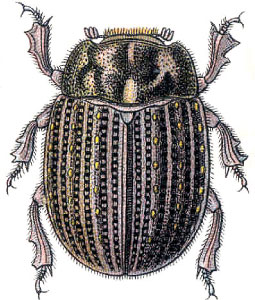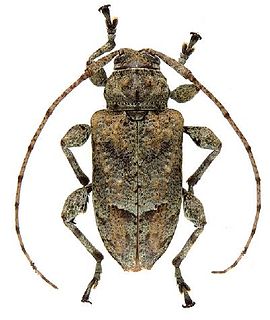
Trogidae, sometimes called hide beetles, is a family of beetles with a distinctive warty or bumpy appearance. Found worldwide, the family includes about 300 species contained in four or five genera.

Leptostylopsis annulipes is a species of longhorn beetles of the subfamily Lamiinae.

Cebrionini is a tribe of click beetles from the family Elateridae; formerly ranked as a subfamily or family, they are now considered a tribe within the subfamily Elaterinae.

Bruchidius siliquastri is a species of bean weevil. It was first found in pods of Cercis siliquastrum in China, and has thence been found in several continents. Its length ranges from 2.8 to 3.7 millimetres. Its body is short and ovate, with a black integument. The apex of its femora and the ventral part of its hind tarsi are reddish. Its vestiture is made of thin and short setae; dorsally setae are a whitish colour, denser on the scutellum. Its pygidium is also covered with setae. Its name is derived from its host plant.

Mecodema kokoromatua is a medium-bodied ground beetle endemic to Northland, New Zealand. Its range is restricted to coastal forest behind the sand dunes and below the southern areas of the Ahipara Escarpment, Herekino, Northland, New Zealand. This species is within the curvidens species group and is related to the geographically widespread M. parataiko.

Chilocorus nigritus, sometimes referred to as the Malaysian ladybird beetle, is a species of lady beetle in the family Coccinellidae. It is native to SE Asia, but has been introduced for use in biological pest control in Hawaii and any parts of the world, including Europe.
Zaitzevia elongata is a species of riffle beetle which is wingless and flightless. It is found on several of the Ryukyu Islands in Japan in the gravel substrate of streams.
Coelostoma (Holocoelostoma) stultum, is a species of water scavenger beetle widely distributed in Palearctic and Oriental realms from West Pacific towards Indian Ocean, such as China, Taiwan, Andaman Islands, Myanmar, India, Indonesia, Japan, Korea, Malaysia, Mascarene Islands, Nicobar Islands, Oman, Philippines, Saudi Arabia, South Korea, Sri Lanka, Thailand, United Arab Emirates, Oman, and Vietnam.

Coelostoma (Coelostoma) vitalisi, is a species of water scavenger beetle found in China, Taiwan, Japan, India, Indonesia, Japan, Malaysia, Nepal, Singapore, Sri Lanka, Cambodia, Thailand and Vietnam.
Phaeochrous is a genus of beetles belonging to the family Hybosoridae. The species are widely distributed over tropical Africa, Madagascar, Aldabra, Yemen, South Asia, South-East Asia, New Guinea and Oceanian islands, as well as North and West Australia.
Orphinus (Picorphinus) guernei, is a species of skin beetle found in Sri Lanka.
Chilocorus subindicus, is a species of lady beetle found in India, Sri Lanka and Maldives.
Clambus ceylonicus, is a species of fringe-winged beetle endemic to Sri Lanka.
Phoberus is a genus of hide beetle in the subfamily Troginae. It was initially a subgenus of Trox before taxonomists reorganized it into its own genus. The genus is monophyletic, with all species evolved from a single common ancestor. Most beetle species in the genus live in Africa.
Phoberus elmariae is a species of hide beetle in the subfamily Troginae discovered by the scientists van de Merwe and Scholtz in 2005. Like with many other beetle species, P. elmariae has not been observed again after its discovery, so all knowledge of the species comes from the 16 individual beetles van de Merwe and Scholtz saw during fieldwork.
Phoberus sternbergi is a species of hide beetle in the subfamily Troginae discovered by the scientists van de Merwe and Scholtz in 2005. Like with many other beetle species, P. sternbergi has not been observed again after its discovery, so all knowledge of the species comes from the 8 individual beetles van de Merwe and Scholtz saw during fieldwork.
Phoberus ngomensis is a species of hide beetle in the subfamily Troginae discovered by the scientists van de Merwe and Scholtz in 2005. Like with many other beetle species, P. ngomensis has not been observed again after its discovery, so all knowledge of the species comes from the 166 individual beetles van de Merwe and Scholtz saw during fieldwork.
Phoberus fumarius is a species of hide beetle in the subfamily Troginae discovered by Erwin Haaf in 1953.
Phoberus disjunctus is a species of hide beetle in the subfamily Troginae discovered by coleopterologist Werner P. Strümpher in 2016.
Phoberus herminae is a species of hide beetle in the subfamily Troginae discovered by coleopterologist Werner P. Strümpher in 2016.






